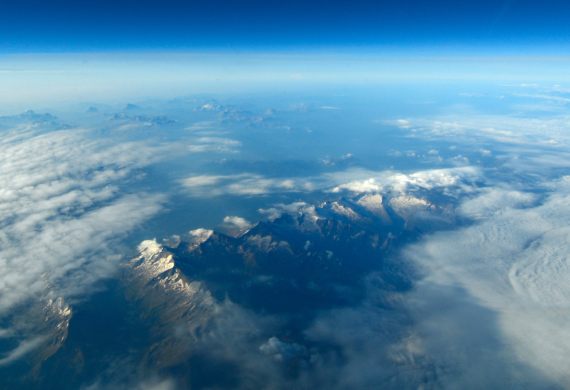Interview David Keith, Professor of Applied Physics at the Harvard School of Engineering and Applied Sciences and Professor of Public Policy at the Harvard Kennedy School, and founder of Carbon Engineering,
What is solar geoengineering? What role could it play in the fight against climate change?
Solar geoengineering is a set of ideas for deliberately altering the Earth’s radiative balance by reflecting a little bit more sunlight back into space, with the goal of reducing some of the long run risks from accumulated CO2.
There’s a big range of solar geoengineering approaches. Moving down from far out in space to the surface, the first one would be making structures, like shields, in space between the Earth and the Sun, to block out sunlight. It may seem a little ridiculous, but this is a 100-year old problem and I don’t think it’s ridiculous to think about it. Although it’s clearly not something we’ll do in the next decades.
The next approach is stratospheric aerosol injection, an approach which has got by far the most research attention and understanding. The core idea is putting aerosols in the stratosphere. There are many types of aerosols which could in principle be put there (the one we understand the best is sulfuric acid), and there are several ways to do it. I think it’s the only approach which could be done relatively soon, starting maybe in a decade, and it could reduce temperatures and many other climate risks in a pretty uniform way.

Then there’s ideas for making thin cirrus clouds (which tend to warm the planet) a little less prominent as well as some seeding ideas for cirrus clouds that haven’t been explored much.
The two last categories would be marine cloud brightening and making the surface brighter by adding to the surface reflectivity (by painting roofs white, for example).
You are co-founder of Harvard’s Solar Geoengineering Research Program. What is the aim of this program?
The aim is to have a broader understanding of these technologies, understand their performance, their environmental risks and how they might be governed.
It’s a very broad program. We fund a big range of researchers, people with a real diversity of views. Some people actually oppose even researching these technologies, so we wanted to have a large range of people involved.
The idea behind the program is to be useful to the world by improving our knowledge of these technologies and the knowledge that policymakers should have in order to make decisions.
Last year the program planned to launch a field test called the Stratospheric Controlled Perturbation Experiment. What was the experiment and why was it finally canceled?
That was a small experiment, led by Harvard Professor Frank Keutsch and myself, designed to try and improve our understanding of the way aerosols behave in the stratosphere and the way aerosol plumes form in the stratosphere. We were attempting to do a flight of just a balloon gondola in Sweden, it wasn’t even the experiment, but it was stopped ultimately by the Swedish government.
Isn’t “playing” with our planet’s temperature dangerous? What are the possible risks?
Nobody should be playing with our planet’s temperature. Obviously, altering the climate is dangerous. That’s why we’re worried about climate change. And we’re trying to deal with the dangers of the accumulated carbon dioxide in the atmosphere. We’re certainly going to put some more carbon dioxide in the atmosphere because we can’t just stop emitting tomorrow.

The issue is how to manage those risks. And yes, it’s certainly true that solar geoengineering, which is one of the ways to limit those risks, has its own set of risks, a big long list of them. So the answer is yes, it is dangerous. But if you are looking for a risk-free solution to a complicated problem like climate change, you’re naive.
If we were to finally go ahead with solar geoengineering: who should be in charge of monitoring the effects? How would we make sure that it was responsibly governed?
We can’t make sure it is responsibly governed. After all, we can’t make sure the internet is responsibly governed. There are many sorts of things we can’t govern responsibly. We haven’t governed the distribution of vaccines very responsibly and we haven’t responsibly governed emissions cuts. There is no global sovereignty.
What individuals can do is to attempt to do their best, to try to advocate ways that this could be done with some justice, in ways that are consultative and practical. That’s what I try to do. There is no magic answer where you can guarantee that it will be done correctly. Trying to be transparent and honest about how effective it might be and what the risks are, and trying to talk practically about how decisions can actually be made; those are the most important things that anyone can do.
It is also important to consider two sides of the risk coin. It is true that there are risks in solar geoengineering and there are ways humans might do it and regret it, and that it would end up being worse than if we hadn’t. But there’s also the opposite. There are risks that if we don’t do it, we miss the opportunity of saving a lot of lives and reducing climate risks in the next half century. Both risks are real.
Solar geoengineering is highly controversial. In January this year a group of 60 scientists signed an open letter calling on political institutions to place limits on solar geoengineering research so that it cannot be deployed unilaterally by countries, companies or individuals. What is your opinion?
Solar geoengineering is an idea, you can’t really be in favor of or against it. You can be against or in favor of certain kinds of research or its deployment under certain circumstances. But you can’t be for or against the idea itself.
I’m not for nor against solar geoengineering. I’m in favor of learning more and there are people who are against that and they have their reasons. I’m against some kinds of deployment.
The controversial part of this letter was that the group was very close to asking for a permanent de facto ban on research. They argued there should be no assessment by the IPCC, no government funding for research and no research that is empirical. They’re not in favor of research, period.

In my opinion, to begin with, it’s an odd ethical position because, after all, the people who signed this letter are mostly rich-world people, in cooler countries, which are mostly isolated from climate risks. And they’re suggesting we do less research on something that, at least given current evidence, is most useful for reducing climate risk, particularly for the most vulnerable, for poor people who live in hotter countries.
It’s quite a thing to say that we should just know less, that we shouldn’t learn more about things, including learning more about its risks. You have to be extraordinarily confident that a thing makes no sense to say that. And they didn’t offer any basis for that. The argument that they gave was that it couldn’t be governed justly, where they defined justly as some kind of collaborative thing where everybody gets to be consulted. And they’re right, it can’t be governed that way, because that’s not the way the world is now.
But if you were to say that we shouldn’t deploy technologies without that kind of governance, you also should not deploy the COVID vaccines, because the COVID vaccines have a possible misuse. The underlying technology can be used for weapons, and they weren’t used justly. They didn’t meet those governance criteria. So if you really believe that nothing that doesn’t meet that criteria should be deployed or researched, then you basically shut down all research on anything. It’s a very high claim.
Will our generation witness the deployment of solar geoengineering?
I don’t know. I don’t think people are good at guessing these things. Even if the technology already exists. Many technologies that are possible have never been implemented. It’s very difficult to guess what technologies will end up being implemented. I, at least, cannot.
David Keith
Comments on this publication